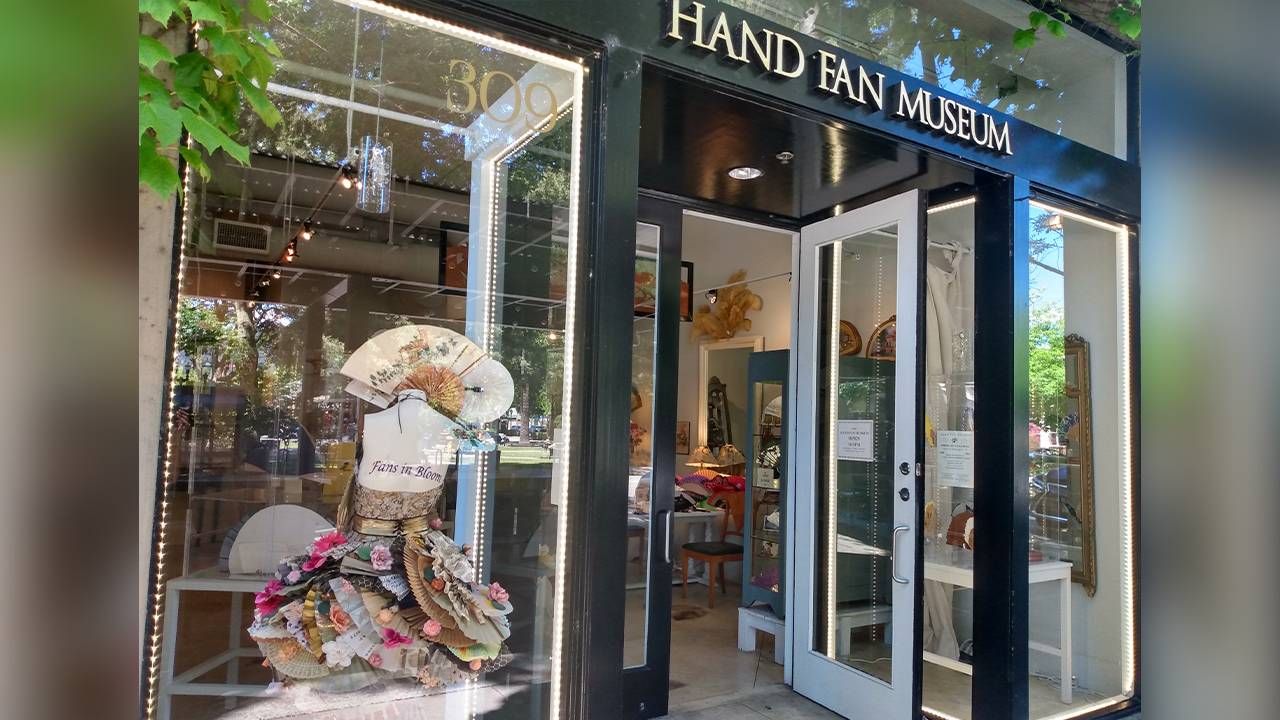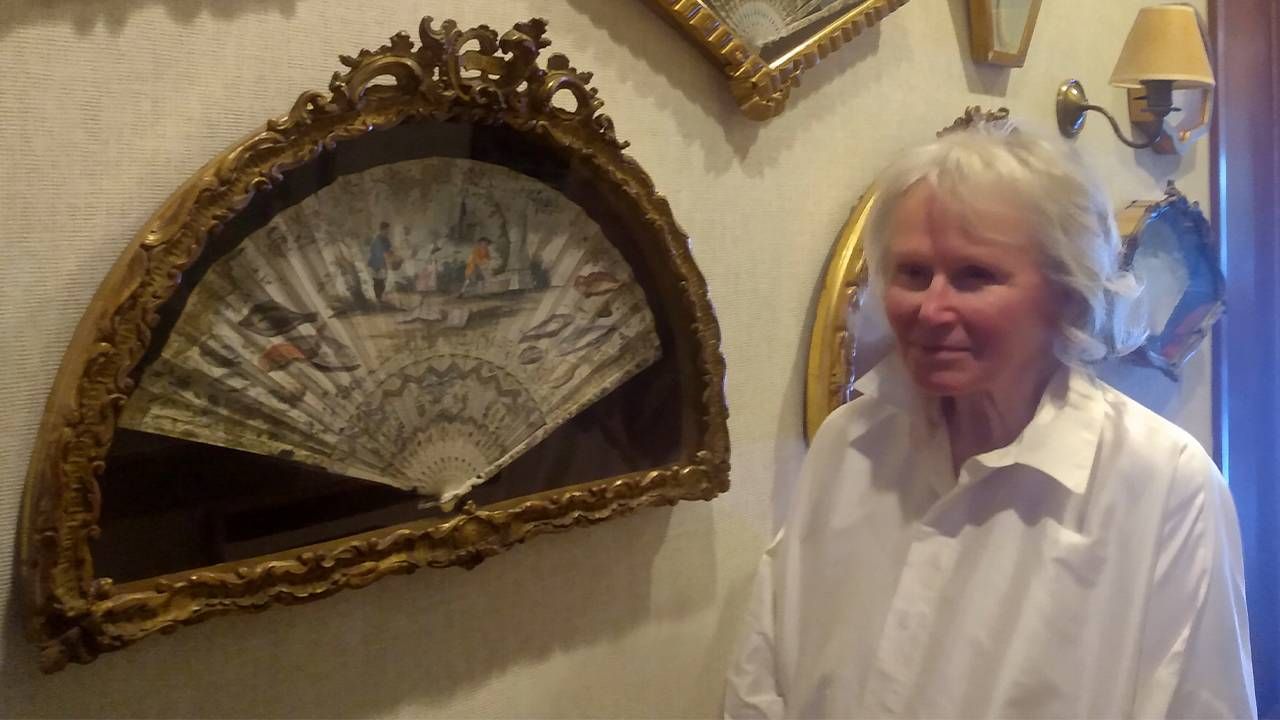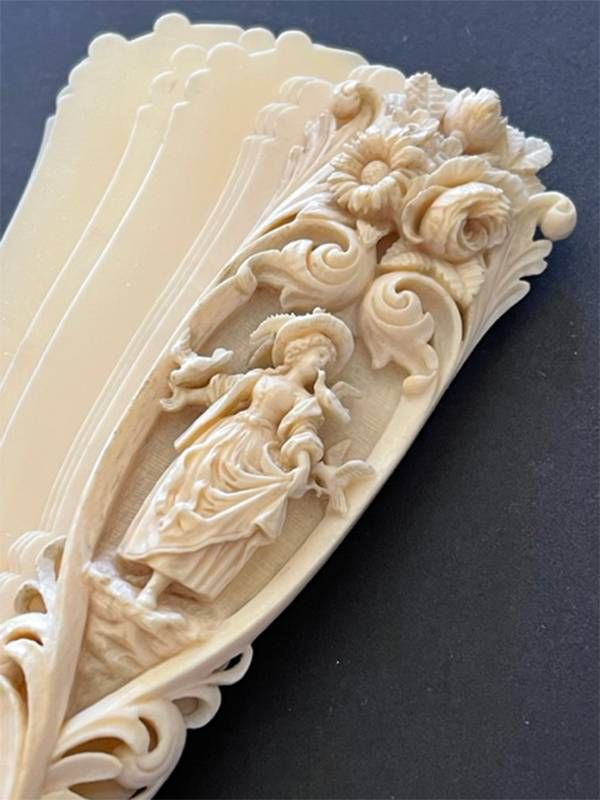The Ultimate Fan of Fans
A cool hobby combines the passions of an art and history lover
Pam Sher, 83, is a fan of, well, fans. She's collected about 2,000 fans over the past 50 years, and her passion drove her to open the only museum in North America devoted to fans, the Hand Fan Museum in Healdsburg, California, in the Sonoma County wine region 70 miles north of San Francisco.

Captivated by the craftsmanship behind the mini art works, she's also enchanted by the history of fans, used for thousands of years dating back to ancient Egypt, Greece and Asia, for practical use — cooling yourself on a hot day — as well as for fashion, religion and ceremony.
"There is no country on this earth, except for Antarctica, that hasn't had fans, from Europe, Asia, Micronesia and Africa to the Arctic."
Many depict hand-painted romanticized pastoral or mythological scenes, flowers, birds, fish, historic or political events, and famous people, from Napoleon to Elvis. Others display maps (such as neighborhoods in Paris or roads to the Cotswolds region of England), dogs, meowing cats or puzzles.
Art and Beauty
Usually made of ivory, tortoiseshell, mother-of-pearl, wood or bone at the base, plus paper or silk at the top, some have unusual shapes. One Chinese fan Sher owns is shaped like a fish when folded. A century-old fan is bat-shaped. She displays between 30 to 60 fans from her collection during themed exhibits.
"Fans are art and beauty," says Sher. "There is no country on this earth, except for Antarctica, that hasn't had fans, from Europe, Asia, Micronesia and Africa to the Arctic."
Fans meld her passions for art and history, adds Sher, who once taught both subjects at Lowell High School, a public school in San Francisco. She says the 18th and 19th centuries were the golden age for fans in the Western world, where it was an accessory for fashionable women.
"One thing that impressed me was the museum's variety and the ability to do changing exhibits on themes, like one on love around Valentine's Day," says Kathryn Hanna, president of The Fan Association of North America, noting that Sher, its ex-archivist for 20 years, gave a Zoom presentation to members based on that exhibit.
The museum's spring 2022 theme was flowers, so a burgundy-colored satin fan featuring hand-painted tulips and gilt-designed base (France, 1890-1900), and a leather fan with hand-embroidered blue and white flowers, a butterfly and wheat, circa 1900, were on display. Sher commissioned an artist to make a show-stopper of a window display, a cocktail dress composed of fans.
Displaying fans is important because, though some museums have fans, such as the Boston Museum of Fine Arts, Ringling Museum of Art in Sarasota, Florida, and San Francisco's de Young Museum, "99.9% of the fans are in storage," says Hanna, a greater Minneapolis resident whose collection of over 400 fans is mostly 20th century and contemporary styles.

A Leap Forward in Fan Technology
The folding fan was invented in the seventh century in Japan, notes Hanna, who wrote "Fans and Fashion," an article in the Journal of Antiques and Collectibles. Fans were flat before that. But flat fans also served later as fire screens to shield faces (and wax-based cosmetics) from the heat of a roaring fire, and as an advertising medium.
Advertising fans promoting local businesses became popular in the late 19th and early 20th centuries in Europe and the U.S. At her home in Marin County, Sher shows me a flat advertising fan depicting a lovely woman with wavy dark hair that promotes the Cotton Club in Harlem. Women in frilly outfits dance the can-can, a Black musician performs and a waiter holds a dead rat by the tail on a fan from Rat Mort ("the dead rat"), a famous nightclub in Paris that was patronized by artists and writers. A woman with a box of chocolates promotes a grocery in Indiana, a bride in a flower-bedecked veil, a bridal shop.
Airlines, such as Northwest Airlines, China Air and SAS have handed out promotional fans. Ad fans are "quintessentially American," says Sher, who aims to acquire fans from small towns all over California.
In the museum, a spectacular group of fans in gilded carved frames under glass line a wall. Gold leaf designs and a pastoral scene of aristocrats adorn a French fan, circa 1740. Fish, shells and fishermen holding a net, bag and fish, plus guards shaped like a dolphin, decorate a 1735 fan, probably Italian.
Sher also owns some Chinese "100 faces" fans (sometimes called "1,000 faces" fans), which are lacquer fans designed as exports to Europe in the mid-19th century when chinoiserie in furniture, porcelain and art gained favor. The fans feature a black, gold or red lacquer figurative design on the sticks, and boldly-colored portrayals of Chinese people in royal interiors or outdoors, whose faces were inset with ivory, illustrating stories, historic scenes and events on the leaf.

Sher's fan obsession began when she was an adult and spotted an ad fan for a Viennese glove-maker that displayed the cute face of a pug in an antiques shop in the U.S. Since her family pets were often pugs, she was smitten.
On frequent travels with her late husband, she scoured antique shops, estate sales and markets looking for more. Being small and easy to pack, fans were the perfect souvenir. "I found it was taking me into parts of cities I would not normally go," Sher says. "It opened the doors to a whole new world."
Finding Fellow Fan Fanatics
In a tourism magazine on one trip, Sher learned of a fan museum in London. She met "so many kind, interesting and welcoming people," who urged her to collect fans. Back then, she was raising three children and doing volunteer work. But she looked into it and found a club for fan enthusiasts in Northern California, the East Bay Fan Guild, to learn more.
Sher, who has created fans as wedding gifts for her family, also involves the community in her hobby. In an imaginative use of fans as a teaching aid, she brought a Navajo fan made of feathers, a "moral compass" fan used by young girls in Colonial times and bags of feathers to fourth-graders in local schools. Told each color signified a certain trait, like loyalty or responsibility, the kids were asked to make a fan after picking five feathers, representing either traits they already had or aspired to.
"I think of fans as a sneaky way of introducing some history."
"I think of fans as a sneaky way of introducing some history. History is the subject that's probably the least attractive class for young people," says Sher.
This spring, a contest invited children ages 6 to 11 to pick up a blank fan at her museum and design their own nature-themed fans. The prize: a certificate for a free book at local bookstore. In a previous contest for kids, the winner won a certificate for a treat from the ice cream shop next to the museum.
Sher's museum is inside the Hotel Healdsburg, a low-rise lodge on a plaza her husband developed that also includes Dry Creek Kitchen, a restaurant from chef Charlie Palmer.
Her advice to people with hobbies: "Have fun! Let other people know what you're doing. A new world may unfold, as fans did for me."
Read More

